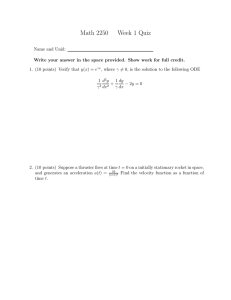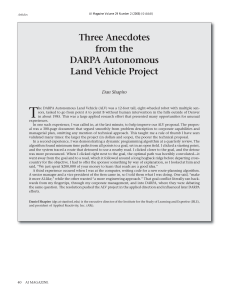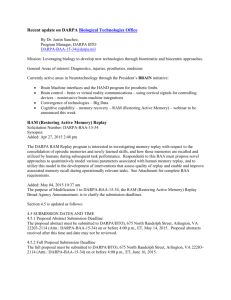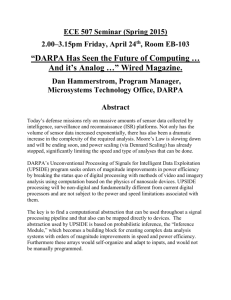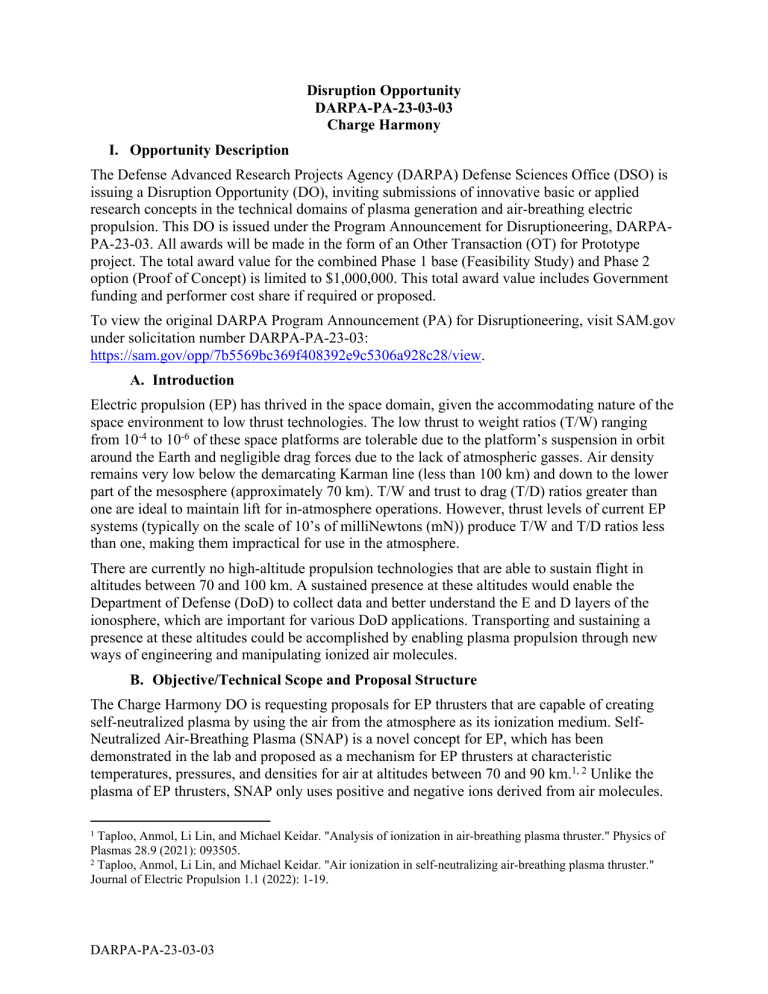
Disruption Opportunity DARPA-PA-23-03-03 Charge Harmony I. Opportunity Description The Defense Advanced Research Projects Agency (DARPA) Defense Sciences Office (DSO) is issuing a Disruption Opportunity (DO), inviting submissions of innovative basic or applied research concepts in the technical domains of plasma generation and air-breathing electric propulsion. This DO is issued under the Program Announcement for Disruptioneering, DARPAPA-23-03. All awards will be made in the form of an Other Transaction (OT) for Prototype project. The total award value for the combined Phase 1 base (Feasibility Study) and Phase 2 option (Proof of Concept) is limited to $1,000,000. This total award value includes Government funding and performer cost share if required or proposed. To view the original DARPA Program Announcement (PA) for Disruptioneering, visit SAM.gov under solicitation number DARPA-PA-23-03: https://sam.gov/opp/7b5569bc369f408392e9c5306a928c28/view. A. Introduction Electric propulsion (EP) has thrived in the space domain, given the accommodating nature of the space environment to low thrust technologies. The low thrust to weight ratios (T/W) ranging from 10-4 to 10-6 of these space platforms are tolerable due to the platform’s suspension in orbit around the Earth and negligible drag forces due to the lack of atmospheric gasses. Air density remains very low below the demarcating Karman line (less than 100 km) and down to the lower part of the mesosphere (approximately 70 km). T/W and trust to drag (T/D) ratios greater than one are ideal to maintain lift for in-atmosphere operations. However, thrust levels of current EP systems (typically on the scale of 10’s of milliNewtons (mN)) produce T/W and T/D ratios less than one, making them impractical for use in the atmosphere. There are currently no high-altitude propulsion technologies that are able to sustain flight in altitudes between 70 and 100 km. A sustained presence at these altitudes would enable the Department of Defense (DoD) to collect data and better understand the E and D layers of the ionosphere, which are important for various DoD applications. Transporting and sustaining a presence at these altitudes could be accomplished by enabling plasma propulsion through new ways of engineering and manipulating ionized air molecules. B. Objective/Technical Scope and Proposal Structure The Charge Harmony DO is requesting proposals for EP thrusters that are capable of creating self-neutralized plasma by using the air from the atmosphere as its ionization medium. SelfNeutralized Air-Breathing Plasma (SNAP) is a novel concept for EP, which has been demonstrated in the lab and proposed as a mechanism for EP thrusters at characteristic temperatures, pressures, and densities for air at altitudes between 70 and 90 km.1, 2 Unlike the plasma of EP thrusters, SNAP only uses positive and negative ions derived from air molecules. Taploo, Anmol, Li Lin, and Michael Keidar. "Analysis of ionization in air-breathing plasma thruster." Physics of Plasmas 28.9 (2021): 093505. 2 Taploo, Anmol, Li Lin, and Michael Keidar. "Air ionization in self-neutralizing air-breathing plasma thruster." Journal of Electric Propulsion 1.1 (2022): 1-19. 1 DARPA-PA-23-03-03 This air-breathing EP system sheds the heavy weight typically associated with space EP systems, which carry their own ionization gas (e.g., a tank of helium-xenon). Additionally SNAP EP would not require an external electron neutralization source at the thruster exit plane, further reducing complexity and weight of an in-atmospheric EP platform. Optimization of T/D for an EP thruster that utilizes self-neutralized plasma composed entirely of positive and negative ions will require techniques for shaping the electromagnetic fields that guide the plasma from the inlet to the outlet of the thruster. Electromagnetic fields that keep the ions off of the walls of the thruster should reduce the drag on the thruster and potentially reduce the negative impacts of oxidation caused by oxygen molecules and ions interfacing with the inner walls of the thrust chamber. Charge Harmony proposals are limited to 8 pages. Proposals must include a Phase 1 base (Feasibility Study) and Phase 2 option (Proof of Concept). Proposals should include a notional diagram of the proposed thruster design and present preliminary analyses that explain plans to meet objective values for performance metrics at the end of Phase 1 and Phase 2 as shown in Table 1, below. Phase Objective 1 2 1 and 2 Variable Objective Value Thrust (T) Thrust/Drag ratio (T/D) Air parameters at altitude 1N >1 70 – 90 km Table 1: Charge Harmony proposal metrics. In Phase 1, performers will demonstrate the feasibility of their SNAP EP thruster geometry with a subscale test, using self-neutralized air breathing plasma that they create. A “subscale” configuration can be a geometry that is scaled down but still answers the fundamental physics questions. This can be done with the creation of scalable densities and velocities of plasma as input to calculating thrust, created as a function of scalable power (for example, starting with 10’s of Watts in the lab scale scalable to 10’s or 100’s of kWatts in an operational setting) and current (A) input and voltages applied (V) to various elements of the thruster, both for plasma generation and beam guidance. The results of Phase 1 will determine if the geometry under investigation could work as a full-sized SNAP EP thruster. During Phase 1, the performer will demonstrate scaled-down testing for different EP geometries of their choice (e.g., Hall effect, gridded, collimated, etc.) for usability in a SNAP EP thruster. In Phase 1, the performer will analyze neutralization of the plume to avoid space charge formation; provide analyses done on scalability (power, thrust) of the self-neutralizing air-breathing thruster; and study air plasma-material interaction to provide assurance that oxidation and other materials issues are mitigated based on innovative solutions. Before progression to Phase 2, performers must demonstrate a thrust of at least 1N. In Phase 2, the performer will scale up their thruster concept to a size that is representative of an operational setting, including current, voltage, size, power, and weight of a notional power supply. The performer will refine power input required to achieve T/D greater than 1 for a performer defined platform with its own notional size, weight and power (SWAP). Instead of forcing higher power (with larger, heavier power supplies) into the thruster to generate more plasma, the performer is encouraged to focus on optimized plasma beam shaping with electromagnetic techniques that keep the plasma off the inner walls of the thruster and accelerate DARPA-PA-23-03-03 it out of the thruster exit plane with an enabling power supply that could enable T/D > 1. This full-sized thruster should also concurrently be optimized with respect to material degradation minimization (e.g., minimizing oxidation by keeping the plasma off of the flow channels). Proposals submitted in response to this DO must be unclassified and must address two independent and sequential project phases: a Phase 1 Feasibility Study (base) and a Phase 2 Proof of Concept (option). The periods of performance for these phases are 12 months for the Phase 1 base effort and 12 months for the Phase 2 option effort. Combined Phase 1 base and Phase 2 option efforts for this DO should not exceed 24 months. The Phase 1 (base) award value is limited to $400k. The Phase 2 (option) award value is limited to $600k. Both Phase 1 and Phase 2 award value limits include performer cost share, if required or if proposed. The total award value for the combined Phase 1 and Phase 2 is limited to $1,000,000. This total award value includes Government funding and performer cost share, if required or if proposed. C. Schedule/Milestones Proposers must address the following fixed payable milestones in their proposals. Proposers must complete the “Schedule of Milestones and Payments” Excel Attachment provided with this DO to submit a complete proposal and fulfill the requirements under Volume 2, Price Volume. If selected for award negotiation, the fixed payable milestones provided will be directly incorporated into Attachment 3 of the OT agreement (“Schedule of Milestones and Payments”). Proposers must use the Task Description Document template provided with the Program Announcement DARPA-PA-23-03, which will be Attachment 1 of the OT agreement. The following is a list of desired milestones and suggested months at which the milestones should be complete. The months at which the milestones occur may be adjusted depending on the proposer’s length of proposed phases and their respective plans for when the proposer believes their milestones may occur. Milestones listed below should mirror the milestones in Schedule of Milestones and Payments Attachment. Phase 1 fixed milestones for this program must include, at a minimum, the following. Month 1: Kickoff meeting presentation on general approach and design for sub-scale thruster, and summary of technical plans for Phases 1 and 2. Month 2: Intermediate report detailing (1) the predicted performance and associated analysis of self-neutralized plasma (SNAP) design and (2) sub-scale thruster manufacturing and assembly plan. Month 6: Report detailing the as-built configuration of the sub-scale thruster assembly, reflecting readiness for testing. Month 7: Report detailing the results of sub-scale thruster testing. The report will detail data acquired and analysis of thruster performance (e.g., measured thrust and plasma characterization; inspection of materials for damage and lifetime; measured voltage, power, and other electrical consumables needed to create plasma and sustain thrust) and other data needed to inform performance of platform at desired altitude. Month 10: Final report outlining predicted thruster performance for notional platform design as compared to variables shown in Table 1. Performance to be estimated using believable SWAP metrics for a platform at this altitude. Review meeting. Month 12: Design for full-scale thruster to be pursued in follow-on Phase 2 option – optimized for an operational system platform. DARPA-PA-23-03-03 Phase 2 (option) fixed milestones for this program must include, at a minimum, the following: Month 13: Phase 2 kickoff meeting presentation on detailed Phase 2 technical approach, including updated analysis for full scale thruster design optimization, and full-scale manufacturing and assembly plan. Month 18: Report detailing the as-built configuration of the full scale thruster assembly, reflecting readiness for testing. Month 20: Report detailing the results of full-scale thruster testing. The report will include data acquired and analysis of thrust performance (e.g., measured thrust; inspection of materials; and measured voltage, power, and other electrical consumables needed to create plasma and sustain thrust) to inform performance of platform at desired altitude. T/D is calculated based on notional platform and power supply needed for SNAP EP thruster. Month 24: Final report and review meeting. Final report outlining predicted thruster performance for notional platform SWAP. Performance to be estimated using believable SWAP metrics for a power supply and platform at this altitude. For planning and budgetary purposes, proposers should assume a program start date of November 28, 2023. Schedules will be synchronized across performers, as required, and monitored/revised as necessary throughout the program’s period of performance. All proposals must include the following meetings and travel in the proposed schedule and costs: To foster collaboration between teams and disseminate program developments, a two-day virtual Principal Investigator (PI) meeting will be held approximately every six (6) months. Regular teleconference meetings will be scheduled with the Government team for progress reporting and problem identification and mitigation. Proposers should also anticipate at least one site visit per phase by the DARPA Program Manager, during which they will have the opportunity to demonstrate progress towards agreed-upon milestones. D. Deliverables Performers will be expected to provide, at a minimum, the following deliverables: Negotiated deliverables specific to the objectives of the individual efforts. These may include registered reports, experimental protocols, publications, intermediate and final versions of software libraries, code, and APIs, including documentation and user manuals, and/or a comprehensive assemblage of design documents, models, modeling data and results, and model validation data. Proposed and to-be manufactured (to be built for the demo test) designs of thruster at the end of Phase 1 (and Phase 2, if proposed). Data pertaining to experiments conducted on the thruster configurations and analyses of that data as it pertains to required thruster performance specified by DARPA. II. Award Information Selected proposals that are successfully negotiated will result in the award of an OT for Prototype project. See Section 3 of DARPA-PA-23-03 for information on awards that may result from proposals submitted in response to this announcement. DARPA-PA-23-03-03 Proposers must review the model OT for Prototype agreement provided as an attachment to DARPA-PA-23-03 prior to submitting a proposal. DARPA has provided the model OT to expedite the negotiation and award process and ensure DARPA achieves the goal of Disruptioneering, which is to enable DARPA to initiate a new investment in less than 120 calendar days from idea inception. The model OT is representative of the terms and conditions that DARPA intends to include in all DO awards. The task description document, schedule of milestones and payments, and data rights assertions requested under Volumes 1, 2, and 3 will be included as attachments to the OT agreement upon negotiation and award. Proposers may suggest edits to the model OT for consideration by DARPA and provide a copy of the model OT with track changes as part of their proposal package. DARPA may not accept suggested edits. The Government reserves the right to remove a proposal from award consideration should the parties fail to reach an agreement on OT award terms and conditions. If edits to the model OT are not provided as part of the proposal package, DARPA assumes that the proposer has reviewed and accepted the award terms and conditions to which they may have to adhere and the model OT agreement provided as an attachment, indicating agreement (in principle) with the listed terms and conditions applicable to the specific award instrument. To ensure that DARPA achieves the Disruptioneering goal of an award within 120 calendar days from the posting date (August 15, 2023) of this announcement, DARPA reserves the right to cease negotiations when an award is not executed by both parties (DARPA and the selected organization) on or before November 28, 2023. III. Eligibility See Section 7 of DARPA-PA-23-03 for information on who may be eligible to respond to this announcement. IV. Disruption Opportunity Responses A. Proposal Content and Format All proposals submitted in response to this announcement must comply with the content and format instructions in Section 5 of DARPA-PA-23-03. All proposals must use the templates provided as Attachments to DARPA-PA-23-03and the “Schedule of Milestones and Payments” Excel Attachment provided with this DO and follow the instructions therein. Information not explicitly requested in DARPA-PA-23-03, its Attachments, or this announcement may not be evaluated. B. Proposal Submission Instructions Responses to DARPA-PA-23-03-03 shall be submitted electronically to DARPA’s Broad Agency Announcement (BAA) Portal (https://baa.darpa.mil). DARPA will acknowledge receipt of complete submissions via email and assign identifying numbers that should be used in all further correspondence regarding those submissions. If no confirmation is received within two (2) business days, please contact ChargeHarmony@darpa.mil to verify receipt. When planning a response to this DO, proposers should take into account the submission time zone and that some parts of the submission process may take from one (1) business day to one (1) month to complete (e.g., registering for a SAM Unique Entity ID (UEI) number or Tax Identification Number (TIN)). DARPA-PA-23-03-03 Electronic Upload First-time users of the DARPA BAA Portal must complete a two-step account creation process. The first step consists of registering for an extranet account by going to the URL above and selecting the “Account Request” link. Upon completion of the online form, proposers will receive two separate emails; one will contain a username, and the second will provide a temporary password. Once both emails have been received, the second step requires proposers to go back to the submission website and log in using that username and password. After accessing the extranet, proposers may then create a user account for the DARPA Submission website by selecting the “Register your Organization” link at the top of the page. Once the user account is created, proposers will be able to see a list of solicitations open for submissions, view submission instructions, and upload/finalize their proposal. Proposers who already have an account on the DARPA BAA Portal may log in at https://baa.darpa.mil, select this solicitation from the list of open DARPA solicitations and proceed with their proposal submission. Note: proposers who have created a DARPA Submission website account to submit to another DARPA Technical Office’s solicitations do not need to create a new account to submit to this solicitation. All full proposals submitted electronically through the DARPA Submission website must meet the following requirements: (1) uploaded as a zip file (.zip or .zipx extension); (2) only contain the document(s) requested herein; (3) only contain unclassified information; and (4) must not exceed 100 MB in size. Only one zip file will be accepted per full proposal. DARPA will reject full proposals not uploaded as zip files. Technical support for the DARPA Submission website is available during regular business hours, Monday – Friday, 9:00 a.m. – 5:00 p.m. Requests for technical support must be emailed to BAAT_Support@darpa.mil with a copy to ChargeHarmony@darpa.mil. Questions regarding submission contents, format, deadlines, etc., should be emailed to ChargeHarmony@darpa.mil. Questions/requests for support sent to any other email address may result in delayed/no response. Since proposers may encounter heavy traffic on the web server, DARPA discourages waiting until the day proposals are due to request an account and/or upload the submission. Note: Proposers submitting a proposal via the DARPA Submission site MUST (1) click the “Finalize” button for the submission to upload AND (2) do so with sufficient time for the upload to complete prior to the deadline. Failure to do so will result in a late submission. C. Proposal Due Date and Time Proposals in response to this announcement are due no later than 4:00 p.m. on September 29, 2023. As described in Section 5 of DARPA-PA-23-03, full proposal packages must be submitted per the instructions outlined in this DO and received by DARPA no later than the above time and date. Proposals received after this time and date may not be reviewed. Proposers are warned that the proposal deadline outlined herein is in Eastern Time and will be strictly enforced. When planning a response to this announcement, proposers should consider that some parts of the submission process may take from one (1) business day to one (1) month to complete. V. Proposal Evaluation and Selection Proposals will be evaluated and selected in accordance with Section 6 of DARPA-PA-23-03. Proposers will be notified of the results of this process as described in Section 7.1 of DARPA- DARPA-PA-23-03-03 PA-23-03. VI. Administrative and National Policy Requirements Section 8.2 of DARPA-PA-23-03 provides information on Administrative and National Policy Requirements that may be applicable for proposal submission and performance under an award. VII. Point of Contact Information Dr. Tabitha Dodson, PhD, Program Manager, DARPA/DSO, ChargeHarmony@darpa.mil. VIII. Frequently Asked Questions (FAQs) All technical, contractual, and administrative questions regarding this announcement must be emailed to ChargeHarmony@darpa.mil. Emails sent directly to the Program Manager or any other address may result in delayed or no response. All questions must be in English and must include the name, email address, and telephone number of a point of contact. DARPA will attempt to answer questions publicly in a timely manner; however, questions submitted within seven (7) calendar days of the proposal due date listed herein may not be answered. DARPA will post an FAQ list under the DO on the DARPA/DSO Opportunities page at (http://www.darpa.mil/work-with-us/opportunities). The list will be updated on an ongoing basis until one (1) week before the proposal due date. DARPA-PA-23-03-03
